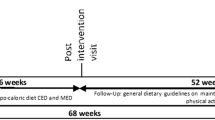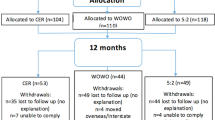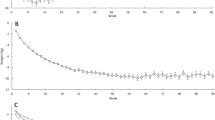Abstract
Objective:
To review weight loss and maintenance for severely obese individuals enrolled in intensive behavioral weight loss program using very-low or low-energy diets.
Design:
Chart review of consecutively treated patients between 1995 and 2002 seen at three weight loss centers.
Subjects:
One thousand five hundred and thirty one patients with severe obesity (⩾40 kg/m2) treated in three cities (‘Study Group’). Of these, 1100 completed the 12-week core curriculum (‘Completer Group’). Weight loss ⩾100 lbs (>45 kg) was seen in 268 patients (‘100-Pound Group’).
Measurements:
Charts were reviewed for baseline characteristics, weekly weights, follow-up weights and side effects.
Results:
In the Study Group, average weight loss±s.e. for 998 women was 23.9±0.6 kg (18.5% of initial body weight (IBW)) and for 533 men was 36.0±1.0 kg (22.5%) over 30 weeks. For Completers, average weight loss for women was 30.8±0.6 kg (23.9%) and for men was 42.6±1.1 kg (26.7%) over 39 weeks. In the 100-Pound Group, average weight loss for women was 58.2±1.2 kg (41.5%) in 65 weeks and for men was 65.7±1.5 kg (37.5%) in 51 weeks. Side effects, assessed in 100 patients losing >45 kg, were mild to moderate in severity. Severe adverse events unrelated to the diet were noted in 5% of patients and during weight loss 1% had elective cholecystectomies. Follow-up weights were available for 86% of Completers at an average of 72 weeks with average maintenance of 23 kg or 59% of weight loss; follow-up weights were available for 94% of the 100-Pound Group at an average of 95 weeks with average maintenance of 41 kg or 65% of weight loss maintained.
Conclusions:
Intensive behavioral treatment with meal replacements is a safe and effective weight-loss strategy for selected severely obese individuals.
This is a preview of subscription content, access via your institution
Access options
Subscribe to this journal
Receive 12 print issues and online access
$259.00 per year
only $21.58 per issue
Buy this article
- Purchase on Springer Link
- Instant access to full article PDF
Prices may be subject to local taxes which are calculated during checkout


Similar content being viewed by others
References
Freedman DS, Khan LK, Serdula MK, Galuska DA, Dietz WH . Trends and correlates of class 3 obesity in the United States from 1990 through 2000. JAMA 2002; 288: 1758–1761.
James PT, Leach R, Kalamara E, Shayeghi M . The worldwide obesity epidemic. Obes Res 2001; 9: 228S–233S.
Pi-Sunyer FX . Clinical guidelines on the identification, evaluation, and treatment of overweight and obesity in adults – the evidence report. Obes Res 1998; 6: 51S–209S.
Maggard MA, Shugarman LR, Suttorp M, Maglione A, Sugerman HH, Livingston EJ et al. Meta-analysis: surgical treatment of obesity. Ann Intern Med 2005; 142: 547–559.
Snow V, Barry P, Fitterman N, Qaseem A, Weiss K . Pharmacologic and surgical management of obesity in primary care: a clinical practice guideline from the American College of Physicians. Ann Intern Med 2005; 142: 525–531.
Anderson JW . Meal replacement use for patients losing >100 pounds in a behavioral, low-energy diet program. Obes Res 2004; 12: A38.
Anderson JW . Improved long-term maintenance of weight loss with ongoing involvement in weight management program. Obes Res 2004; 12: A41.
Anderson JW, Hamilton CC, Brinkman-Kaplan VL . Benefits and risks of an intensive very-low-calorie diet program for severe obesity. Am J Gastroenterol 1992; 87: 6–15.
Health Management Resources. HMR Program for Weight Management Weight Loss Core Curriculum. Health Management Resources: Boston, MA, 1999.
Health Management Resources. HMR Program for Weight Management Maintenance Phase Class Manual. Health Management Resources: Boston, MA, 2000.
National Cancer Institute. Common terminology criteria for adverse events version ( http://ctep.cancer.gov ) 2003.
Anderson JW, Luan J, Hoie LH . Structured weight-loss programs: a meta-analysis of weight loss at 24 weeks and assessment of effects of intensity of intervention. Adv Ther 2004; 21: 61–75.
Anderson JW, Vichitbandra S, Qian W, Krysico RJ . Long-term weight maintenance after an intensive weight-loss program. J Am Coll Nutr 1999; 18: 620–627.
Anderson JW, Konz EC, Frederich RC, Wood CL . Long-term weight-loss maintenance: a meta-analysis of US studies. Am J Clin Nutr 2001; 74: 579–584.
Anderson JW, Hamilton CC, Crown-Weber E, Riddlemoser M, Gustafson NJ . Safety and effectiveness of a multidisciplinary very-low-calorie diet program for selected obese individuals. J Am Diet Assoc 1991; 91: 1582–1584.
Shiffman ML, Kaplan GD, Brinkman-Kaplan VL, Vickers FF . Prophylaxis against gallstone formation with ursodeoxycholic acid in patients participating in a very-low-calorie diet program. Ann Intern Med 1995; 122: 899–905.
Consumer Expenditure Survey. Average annual expenditure of all consumer units and percentage changes. Table A 2004. Internet: http://www.bls.gov/cex/csxann03.pdf.
US Department of Agriculture. Official USDA Food Plans: Cost of Food at Home at Four Levels, US Average, January 2006. Center for Nutrition Policy and Promotion 2006 2006. Internet: http://www.cnpp/FoodPlans/Updates/foodjan06.pdf.
Steinbrook R . Surgery for severe obesity. N Engl J Med 2004; 350: 1075–1079.
Tremblay A, Doucet E, Imbeault P . Physical activity and weight maintenance. Int J Obes 1999; 23: 50S–54S.
Kruger J, Galuska DA, Serdula MK, Kohl III HW . Physical activity profiles of US adults trying to lose weight. Med Sci Sports Exerc 2005; 37: 364–368.
Votruba SB, Horvitz MA, Schoeller DA . The role of exercise in the treatment of obesity. Nutrition 2000; 16: 179–188.
Fogelhorn M, Kukkonen-Harjula K . Does physical activity prevent weight gain – a systematic review. Obes Rev 2000; 1: 95–111.
Grant L, Gotthelf L . Long-term follow-up of 1000 maintenance patients show substantial lifestyle and medical changes. Obes Res 2005; 13: A203.
McGuire MT, Wing RR, Hill JO . The prevalence of weight loss maintenance among American adults. Int J Obesity 1999; 23: 1314–1319.
Daly A, Konz EC, Soler N, Anderson JW, Yergler C, Carpenter P . Successful long-term management of substantial weight loss: one program's experience. J Am Diet Assoc 2000; 100: 1456–(letter).
Jakicic JM, Otto AD . Physical activity considerations for the treatment and prevention of obesity. Am J Clin Nutr 2005; 82: 226S–229S.
Shick SM, Wing RR, Klem ML, McGuire MT, Hill JO, Seagle HM . Persons successful at long-term weight loss and maintenance continue to consume a low-energy, low-fat diet. J Am Diet Assoc 1998; 98: 408–413.
Howarth NC, Saltzman E, Roberts SB . Dietary fiber and weight regulation. Nutr Rev 2001; 59: 129–139.
Slavin JL . Dietary fiber and body weight. Nutrition 2005; 21: 411–418.
Rolls BJ, Ello-Martin JA, Tohill BC . What can intervention studies tell us about the relationship between fruit and vegetable consumption and weight management. Nutr Rev 2004; 62: 1–17.
Author information
Authors and Affiliations
Corresponding author
Rights and permissions
About this article
Cite this article
Anderson, J., Grant, L., Gotthelf, L. et al. Weight loss and long-term follow-up of severely obese individuals treated with an intense behavioral program. Int J Obes 31, 488–493 (2007). https://doi.org/10.1038/sj.ijo.0803423
Received:
Revised:
Accepted:
Published:
Issue Date:
DOI: https://doi.org/10.1038/sj.ijo.0803423
Keywords
This article is cited by
-
Weight loss and bone mineral density in obese adults: a longitudinal analysis of the influence of very low energy diets
Clinical Diabetes and Endocrinology (2018)
-
Diabetes and Weight in Comparative Studies of Bariatric Surgery vs Conventional Medical Therapy: A Systematic Review and Meta-Analysis
Obesity Surgery (2014)
-
A Review of Unmet Needs in Obesity Management
Obesity Surgery (2012)
-
Bariatric Surgery versus Lifestyle Interventions for Morbid Obesity—Changes in Body Weight, Risk Factors and Comorbidities at 1 Year
Obesity Surgery (2011)
-
Surgical treatment of morbid obesity among patients with bipolar disorder: a research agenda
Advances in Therapy (2011)



